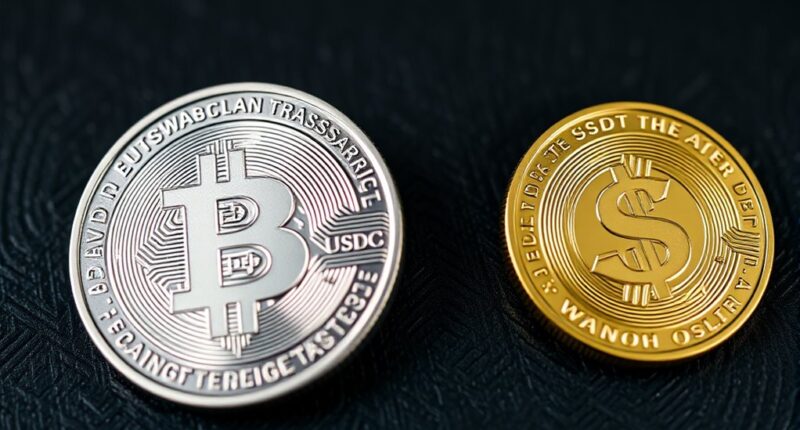If you’re comparing USDC and USDT, transparency and compliance are key. USDC emphasizes regulatory adherence, regular audits, and full reserve backing, which builds trust. USDT, however, has faced scrutiny over its reserve disclosures, raising doubts about transparency. Your choice depends on whether you prioritize legal compliance and clear backing or liquidity and market presence. To understand how these factors impact your decision, keep exploring the details behind each stablecoin’s approach.
Key Takeaways
- USDC emphasizes regulatory compliance and publishes regular third-party attestation reports, boosting transparency and user trust.
- USDT has historically been less transparent about its reserves, leading to ongoing skepticism among investors.
- USDC’s focus on KYC, AML, and multiple audits enhances its security and credibility compared to USDT.
- USDT’s widespread liquidity remains an advantage despite transparency concerns, affecting market dominance.
- The transparency debate influences user preferences, with USDC favored for regulation adherence and USDT for liquidity.

When choosing between USDC and USDT, understanding how each stablecoin operates and what sets them apart is essential. One of the key factors to weigh is how they handle regulatory challenges and their technical robustness. USDC, issued by Circle and backed by Coinbase, emphasizes transparency and compliance with regulatory standards. This focus means that USDC regularly publishes attestation reports from third-party auditors, verifying that each token is fully backed by reserve assets. This transparency builds trust among users who want assurance that their holdings aren’t just claims but actual dollar equivalents. On the other hand, USDT, issued by Tether, has faced ongoing scrutiny over its reserve disclosures. While Tether claims that each USDT is backed by dollar reserves, it has historically been less transparent, leading to questions about its regulatory compliance. The controversy surrounding Tether’s reserves has made some investors wary, especially given past incidents of limited disclosures and audits. This ongoing debate about transparency impacts how both coins are perceived in the broader market, especially as regulators tighten their oversight of stablecoins. Additionally, the differences in blockchain technology used by each coin influence their security and compatibility with various platforms. From a technical robustness perspective, both USDC and USDT are built on blockchain technology, but their infrastructure and security measures differ. USDC is often praised for its rigorous compliance protocols, which include strict KYC (Know Your Customer) and AML (Anti-Money Laundering) procedures. These measures help prevent misuse and ensure that the stablecoin adheres to regulatory standards, making it more resilient against potential legal and operational issues. USDC’s infrastructure is also designed with security in mind, utilizing sophisticated smart contract technology that has been audited multiple times to ensure safety from exploits and vulnerabilities. Conversely, USDT’s long-standing presence in the crypto space has demonstrated its resilience, but it has also experienced security challenges and controversies around its smart contract code. Although Tether has invested heavily in improving its technical infrastructure, questions about its transparency and reserve backing still cast a shadow over its stability and trustworthiness. Ultimately, your choice between USDC and USDT comes down to how much you value regulatory compliance and transparency versus established market presence. USDC offers a more transparent, regulation-friendly option backed by consistent attestations, making it appealing if you prioritize clarity and legal adherence. USDT, while more widely used and liquid, carries the baggage of past transparency issues, which might concern you if regulatory challenges and technical robustness are top priorities. Both stablecoins are evolving, but understanding their differences in these areas helps you make a more informed decision aligned with your risk tolerance and trust preferences.
Frequently Asked Questions
How Do Regulatory Changes Affect USDC and USDT Stability?
Regulatory changes markedly impact USDC and USDT stability by shaping regulatory oversight, which influences how these stablecoins operate. When authorities increase oversight, it can boost market confidence, making users more comfortable holding and transacting with these assets. Conversely, unclear or restrictive regulations might create uncertainty, leading to volatility. Your confidence in these stablecoins depends on how well regulatory developments maintain transparency and safeguard your assets, directly affecting their stability.
What Are the Long-Term Implications of Transparency Concerns?
You should consider that long-term transparency concerns impact trustworthiness and governance transparency, which are vital for stable stablecoins. If issuers don’t address these issues, you might lose confidence, leading to decreased adoption and increased volatility. Over time, a lack of transparency can weaken market stability, prompting regulators to impose stricter rules. As a result, prioritizing transparent governance ensures you maintain trust and stability in your digital assets.
Are There Any Hidden Risks With Each Stablecoin?
You should consider hidden risks with each stablecoin, as transparency concerns can obscure their true financial health. With USDC, there’s a risk if the backing reserves aren’t fully transparent or properly managed, leading to potential insolvency. USDT faces similar issues, with ongoing scrutiny over reserve adequacy. Always stay cautious, as lack of transparency can hide vulnerabilities, and these hidden risks might impact your ability to redeem or rely on the stablecoins during market stress.
How Do Consumer Protections Differ Between USDC and USDT?
You should know that consumer protections differ between USDC and USDT. USDC emphasizes transparency and has stricter security measures, boosting consumer trust through regular audits and clear backing. USDT, while widely used, offers less transparency and fewer security assurances, which can impact your confidence and safety. Ultimately, USDC’s focus on transparency and security helps protect your assets better, making it a more trustworthy option for many users.
Will Transparency Issues Impact Their Adoption by Institutions?
You might wonder if transparency issues will affect institutional adoption. If these concerns undermine market trust, institutions could hesitate to adopt these stablecoins. Compliance standards play a crucial role, as institutions prefer assets that meet rigorous transparency and regulatory requirements. When transparency issues persist, they could slow adoption, making institutions seek more trustworthy options. Ultimately, maintaining high transparency and compliance standards is essential for fostering confidence and encouraging widespread institutional use.
Conclusion
In the ongoing battle between USDC and USDT, transparency remains your top priority. USDC’s clear reserves and regulatory oversight offer peace of mind, while USDT’s widespread adoption keeps it in the game. As a user, staying informed about each stablecoin’s backing and transparency practices helps you make smarter decisions. Ultimately, choose the one that aligns best with your trust and needs, knowing both are evolving to serve you better in the crypto world.









